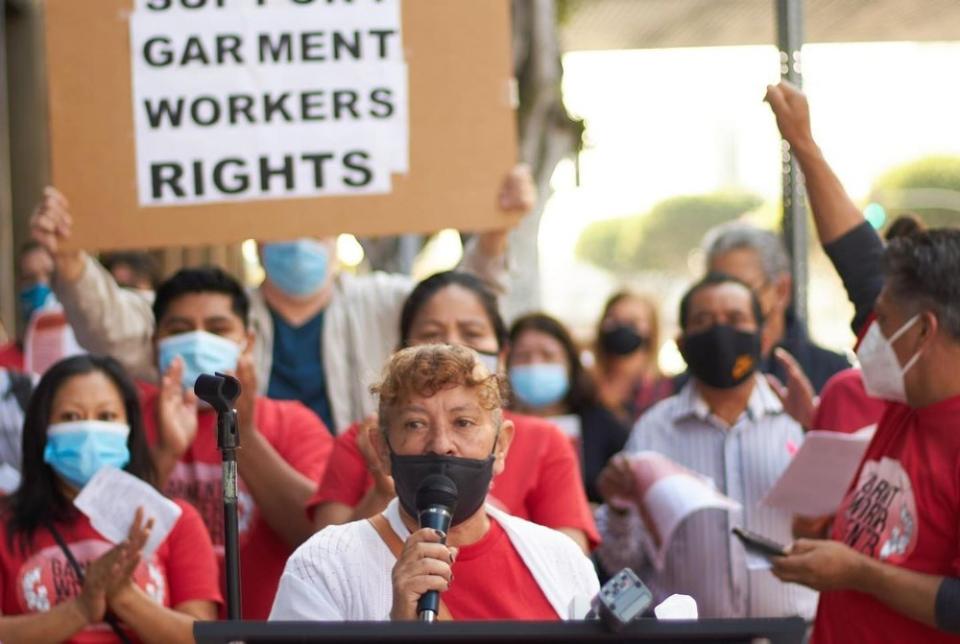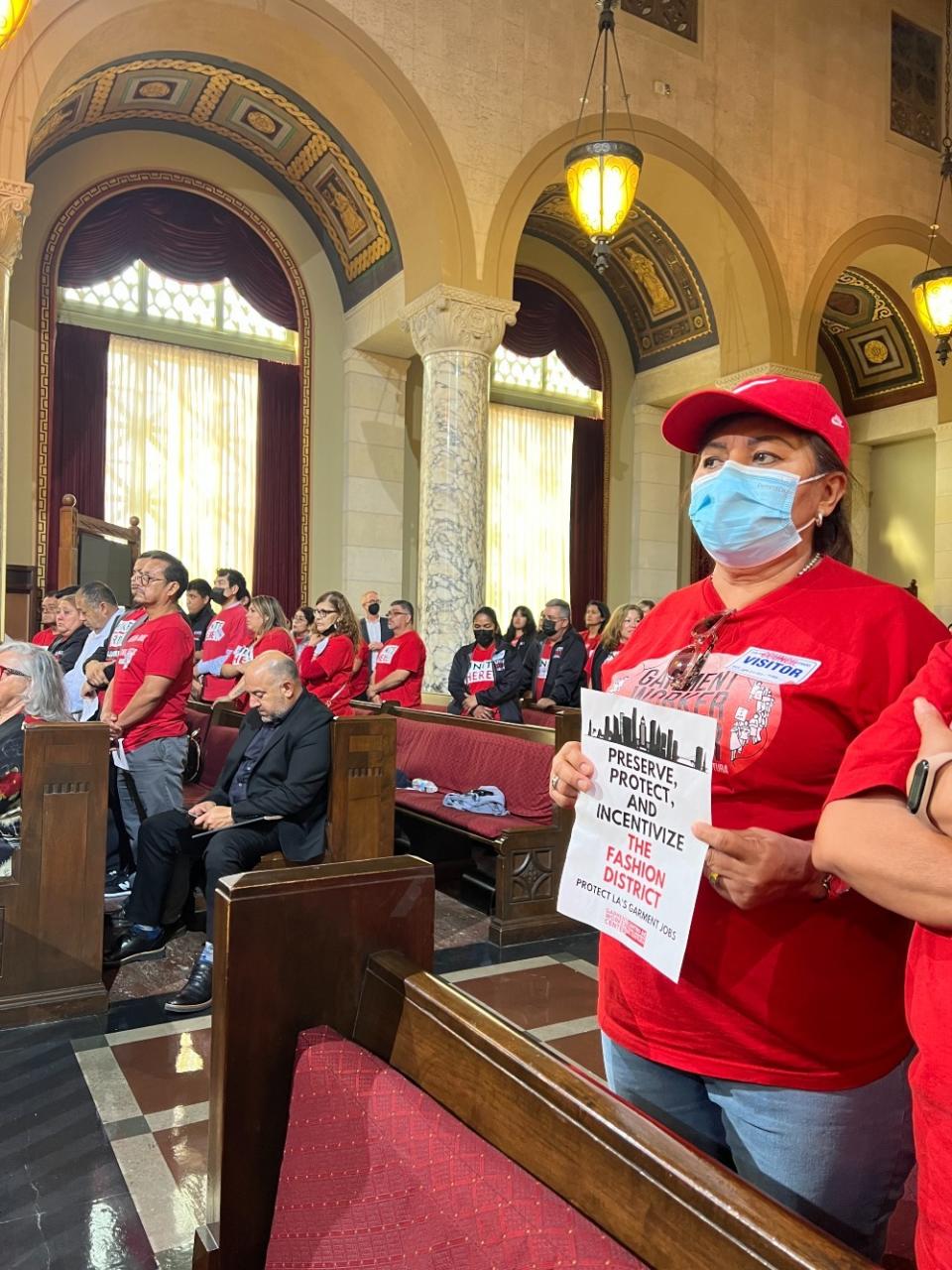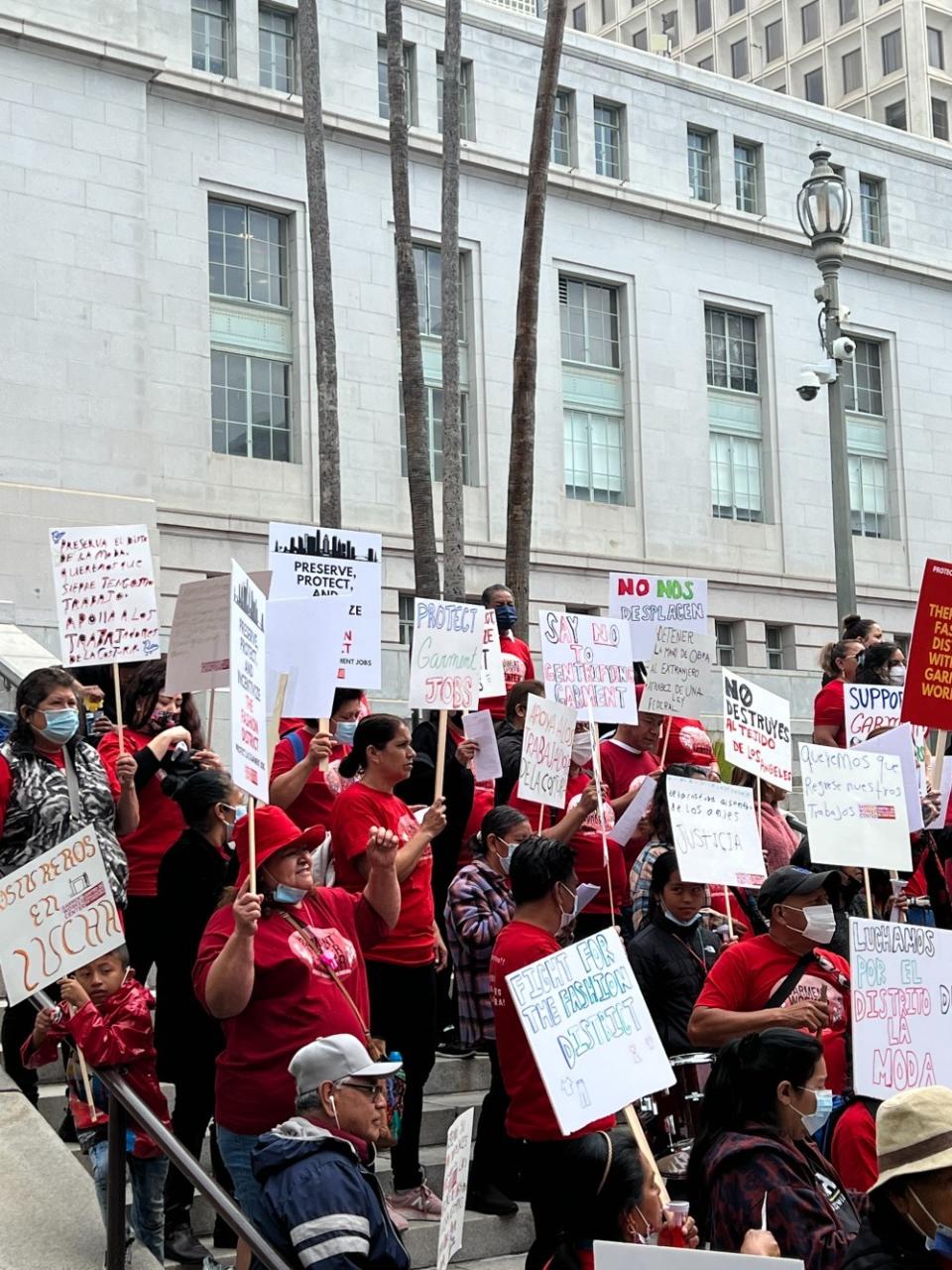LA Fashion District’s Future Looks Brighter Following Amended DTLA 2040 Passage

Los Angeles garment workers and manufacturers are breathing a sigh of relief following a multiyear fight for recognition from local legislators, as their battle against the rezoning of the city’s famed Fashion District came to an end this month.
Workers and advocates have moved on to parsing the provisions and unraveling the implications of the finalized DTLA 2040 Plan, a complex re-mapping of the city’s Downtown districts that aims to see residential land use double over the course of the next 20 years.
More from Sourcing Journal
At a special meeting on April 24, City Council voted to pass the plan, nine years in the making, with the promise of amending certain aspects of the legislation to protect the fashion industry and its workforce from displacement by housing developers. On May 3, the city codified those modifications, ensuring that they move forward as law.
Daisy Gonzalez, campaign director for worker rights organization the Garment Worker Center (GWC) told Sourcing Journal that the group is celebrating a series of wins that it believes will stave off the more disruptive changes put forth in the city’s original plan.
The district’s most contentious battleground was its western lobe, which houses “the highest concentration of garment production” in a zone dubbed IX3, she said. That zone, along with the one next to it, will now be covered by an incentive program that will encourage housing developers to reserve at least 50 percent of new building space for manufacturing purposes. GWC would have naturally preferred to see all eight of the Fashion District’s zones covered by the incentive program, but is encouraged that developers will be compelled to preserve the most industry-dense areas. They will also be prohibited from converting industrial buildings in multiple zones into lofts or hotels.
City Council also approved a requirement that one to two stories in new housing developments be reserved for garment manufacturing in the IX3 zone. “Another thing that we were able to accomplish was stronger guidelines for preventing the displacement of garment manufacturing businesses in existing buildings,” Gonzalez said. When a developer seeks a permit for the construction of housing within those structures, the city must now do its due diligence to ensure that businesses aren’t being forced out.

“We’re also really excited to work with Council members on a workforce development program,” the director added. It represents a first step for the city in analyzing the kinds of benefits that currently exist for garment workers, as well as the tax credits, incentives and training programs that could be developed to benefit the industry’s future, she said.
The group voiced disappointment about an ongoing dispute over retaining production space requirements in the most densely populated areas of the district. In the IX3 zone, for example, developers will be subject to a 1.0 Floor Area Ratio designation. In layman’s terms, if a plot of buildable land measures 100 square meters, then 100 square meters of manufacturing space must be built on that plot. “If the city goes lower,” than that amount, “it will result in a dramatic loss of garment production space and jobs,” GWC said. Property owners and developers in turn argued that maintaining such a production space requirement would restrict housing opportunities, and City Council demanded more research on the issue before finalizing their decision.
Paul Silvern, vice president of HR&A Advisors, Inc., a third-party consulting firm hired by City Planning to provide an economic analysis of the original DTLA 2040 Plan, said he was “optimistic” that the amended legislation created using his firm’s recommendations would “create more housing, while protecting garment industry jobs from displacement.”
One of the primary recommendations of HR&A’s analysis, delivered to City Planning last August after outcry from the fashion industry prompted the Plan’s review, “was to preserve job-dense, multi-story buildings, which would otherwise be ‘low-hanging fruit’ in the marketplace for conversion to housing,” Silvern said. HR&A engaged directly with Fashion District stakeholders like GWC, along with business-owners and workers, to identify strategies to facilitate the protection of garment production throughout 2022. “Those recommendations were directly incorporated into the plan adopted by City decision-makers” this month, he added.
According to Silvern, the buildings in the Fashion District that house the most jobs are historic, multi-story strutures. “Changes to DTLA 2040 to preserve those structures are likely to have the greatest impact on job preservation,” he said. Now, the city must determine how it can help meet housing needs while also increasing space for garment work within new buildings. Many of those construction sites will replace parking lots and single-story buildings that aren’t being used, for example.
The city’s proposed production space ratio allows for “the potential to create new manufacturing,” Silvern said, but the unique needs of fashion tenants—from loading and access points to energy requirements and different lease structures—“may be inconsistent” with real estate market requirements for building housing. In other words, development projects that blend residential and industrial functionality will be a heavy, if not insurmountable, financial lift.
The city can help bridge the gap, Silvern said, by providing grants or funding for new development, along with requiring fashion tenants to sign longer leases or pay rent that covers construction costs. “Without city or other financial support,” it’s likely that the 1.0 FAR fashion manufacturing space requirement “will render such projects financially infeasible,” he believes.
The passage of the DTLA 2040 Plan—which aims to combat L.A.’s massive housing shortage and homelessness epidemic—comes at a tense time for many Angelenos, who are contending with rising living and business costs. The challenges to developing housing solutions “are particularly acute at the moment,” Silvern said, “because of continued impacts of inflation, a constrained construction labor market, and increasing interest rates.”

“These things are cyclical,” he added, “but the more flexibility that cities can provide and the fewer cost burdens that cities mandate will help support more rapid housing production,” including the mixed-income housing that the DTLA 2040 plan calls for.
Alan Mallach, a city planner, advocate and senior fellow with the Center for Community Progress, said that concocting a panacea that satisfactorily addresses the city’s desperate housing needs while helping it grow economically is “basically impossible,” wagering that the tools and capital local government currently has its disposal are simply “not enough” to fully address the problem.
“Building housing in urban areas in California is mind-bogglingly expensive,” Mallach said, noting that he estimates building a “plain, vanilla apartment building” could rack up $500 or more per square foot in construction costs. “If you want to build a rather tight two-bedroom of about 1,000 square feet, you’re talking half-a-million dollars in construction before you even start.” That doesn’t take into account the cost of the lot, permits, architects, lawyers, applications and marketing—“the whole ball of wax.”
The economics don’t work out, Mallach said—and they certainly don’t work out in favor of low earners looking for affordable housing. In L.A., a low-income, four-person family is characterized as one that makes $94,000 per year, based on a calculation of regional median income. “That doesn’t reflect the reality” felt by most residents of the Fashion District, nor do the high costs of building appeal to potential developers required to reserve a portion of their projects for affordable housing.
While the city is intent on funneling money into the creation of housing solutions, Mallach believes that developers won’t be able to square the cost of construction with the money they’re making—especially if the units they build aren’t rented at market rate. The average one-bedroom apartment in Downtown, L.A. rents for $2,720 per month. Meanwhile, up to 2,000 of the 12,000 units the city hopes to see built in the Fashion District’s western zone—where much of the residential building would take place—would be designated as affordable, and could only be rented at a fraction of the market standard.
The methodology and governmental mechanics that brought Downtown, L.A. to this current inflection point are rooted in historical actions, according to Lance Jay Brown, an architect, urban planning expert and former president of the Consortium for Sustainable Urbanization. “I think this country has a history of quasi-autonomous action relative to large-scale urban change,” he said. Shifts of great magnitude in cities across the country have been brought about by urban policy from the federal, state and city levels “that did not have mechanisms in place…to ensure that all people being affected by that change would be given fair and equitable treatment.”
Change tends to happen “in areas that are soft because of lack of political will or financial resources,” according to Brown. “Those things that are seen as fungible tend to get removed more often than those that look as though they’re solid.” The aesthetic appeal of the Fashion District, an industrial enclave made up of decades-old buildings and warehouses, is lacking. “People driving through might think it’s nothing—a desolate area. If you don’t get inside to see and hear the hum of machinery and the action of the workers, you might think that it’s dead,” he said. A vibrant storybook encased in a dingy cover, so to speak.
Zoning laws once served to separate the noisy, polluting aspects of industry from the areas where people live, giving way to land-use designations for residential, commercial, academic, industrial and recreational areas. Now, because of modern society’s advanced technical capacity, “we’ve come back to a slightly greater understanding that there’s value to mixed use, especially in pursuit of a of a walkable environment.” Not all industry needs to be disruptive to comfortable city living. But urban planners must develop effective methods for facilitating a productive mix, allowing light manufacturing like garment work to thrive in concert with residential use and commercial businesses. That’s a delicate balance to strike, and it’s not always workable.

Brown, a native New Yorker, pointed to Manhattan’s shrinking Garment District by way of comparison. The city is fighting to retain the few businesses still left clustered around the Fashion Institute of Technology and the button statue, newly re-gilded, that marks its historical place in the city. But New York is no longer a major producer of fashion, and it likely never will be again. “I’ve watched everything disappear that was connected to this,” Brown said. “Maybe out of my own sense of values and nostalgia, I believe if we have a surviving, thriving garment district in this country, you have to give serious thought to going in and doing anything that could unsettle it.”
In the pursuit of much-needed housing solutions, urban planners should employ “the planning theory of ‘both, and’ as opposed to ‘either, or,’” he added. Protecting industry and promoting housing are not mutually exclusive, but an area’s original residents and stakeholders must be given sufficient consideration and opportunity for engagement in the act of making change. It’s a practice he has employed in helping develop plans for cities across the country and the globe, he said. “I think that we should be intelligent, informed and creative enough to create a compromise,” Brown added. “No, it won’t satisfy everyone. But it will certainly go a long way towards accommodating everyone in a way that’s acceptable.”
There are no easy answers, he admits, but unilateral action is rarely the right one. “You have to look deeply into what the goals and objectives are. You have to consider very carefully what the process and mechanism for making change is. And you have to bring the right people into context to have the discussions to reduce conflict and seek a better resolution.”

